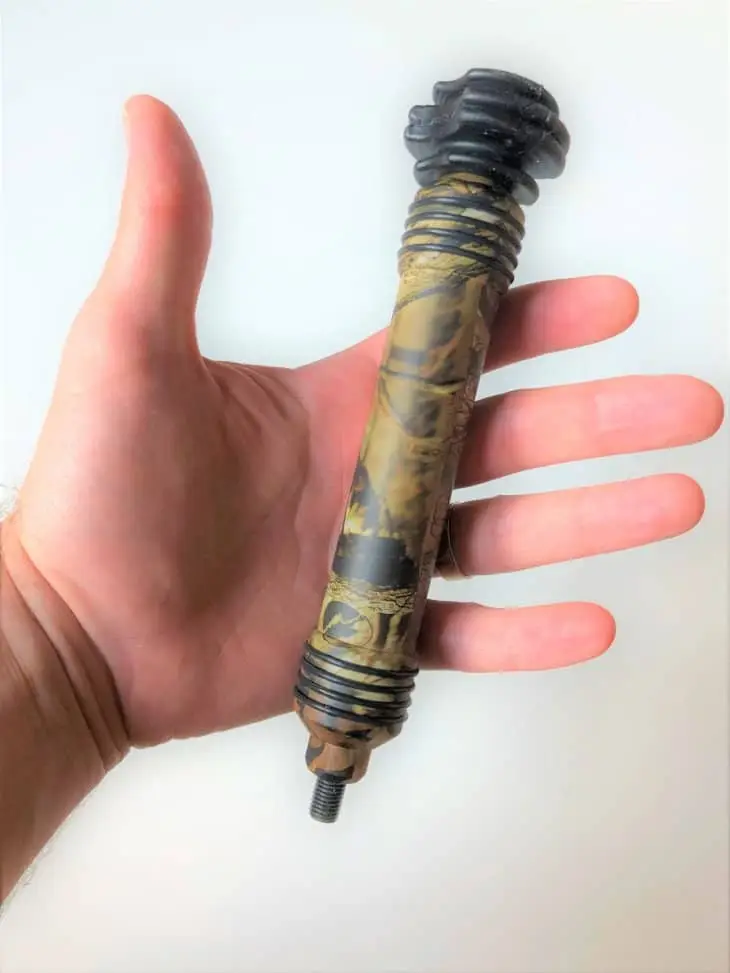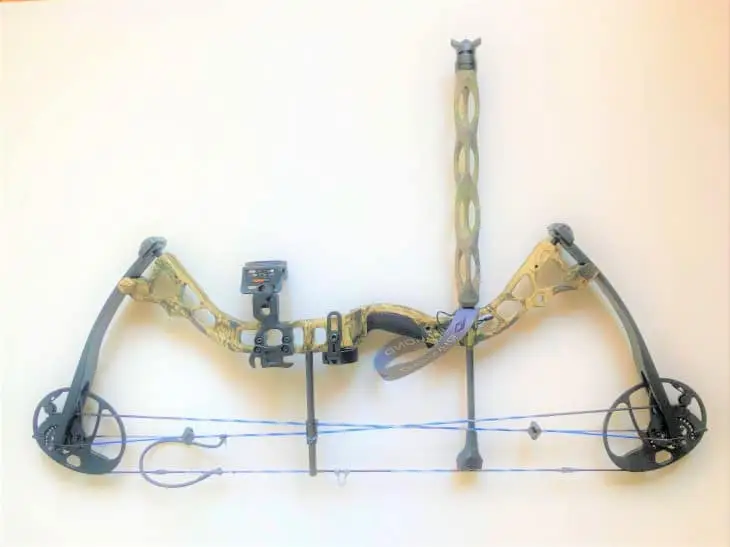Note: Our site links to archery and bowhunting products sold by outside vendors, and we may earn a small commission if you purchase an item after clicking one of these links. Learn more about our affiliate program.
If you’re new to archery, you’ve probably seen a few stabilizers, and if you’ve ever tried to select one for your bow, you’ve probably been absolutely amazed at how complicated a simple rod can be.
In this post, we’ll help de-mystify one of archery’s most simple—and yet, surprisingly, most helpful—tools: the stabilizer.
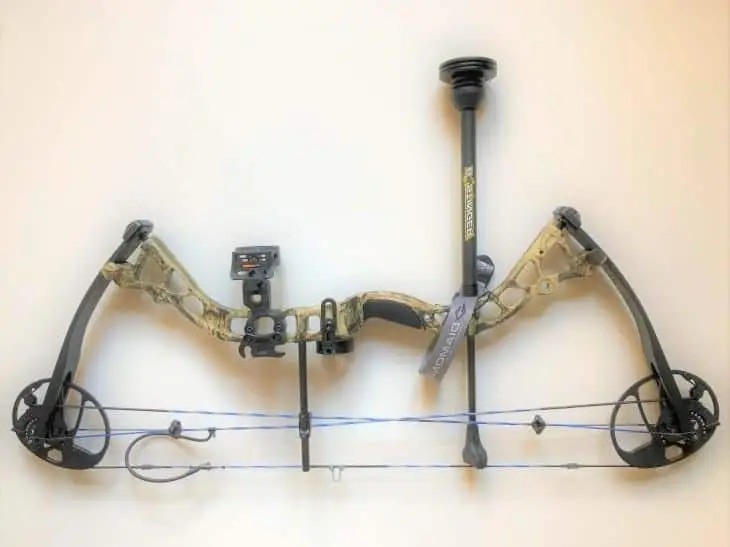
Functions of a Bow Stabilizer
Our “What do stabilizers do?” journey starts simply enough: stabilizers are designed with two goals, and they are 1) to increase your bow’s balance (because balance is a good thing) and 2) to absorb your bow’s vibration during arrow release (because vibration is a bad thing). You’ll find that a lot of the “extra” gear on bows is designed to address those two issues, and there’s a reason for that: a naked bow can be pretty darn unstable.
If you were to look at a slow-motion image of an arrow leaving a bow after release, you’ll see that bow shake like a leaf in a tree. Even with all of our modern advancements—and make no mistake; modern bows are top-to-bottom miracles of physics—the design is still imperfect, as it probably will be for years to come. Bows rattle and twang and twist in your hand when you shoot them.
If you want to experience this first-hand, go to your local archery range, and rent one of their beginner bows. You know—one of the ones they rent out, again and again, to people who come in for birthday parties and work outings and awkward first dates. Slap an arrow on it, draw it, and let loose, and you’ll probably find that thing twists like a hula dancer as your arrow leaves the rest. It doesn’t mean it’s a bad bow (although most of those rental bows do go through the ringer); it’s just a fact about bows. Without a little dressing, many of them are prone to wobbling.
So that’s why a lot of people like stabilizers: increased balance and decreased wobbling.
Let’s take a closer look at those two tasks:
Increased Balance. When you first add a stabilizer to your bow, it’s an interesting sensation, because that puppy can make the darn thing so much heavier. It actually makes it difficult to maneuver, and—at first, anyway—it makes it more difficult to hold and aim.
That’s the whole point, though—you can actually feel the increased steadiness of the bow. With a well-made stabilizer attached to a bow, it’s actually more difficult to rock the bow from side to side. The location of the stabilizer—you usually screw it on the back of the bow (that is, the side facing your target)—may pull the bow down a little bit, and it may require a little extra effort on your part to hold the bow up (and you’ll probably feel a little “burn” in the lower part of your bow forearm). With that extra heft, however, usually comes more stability and equilibrium, and once you get the pin of your bow sight over your intended target, the weight of the stabilizer will make it easier to keep it there. That’s one of the biggest advantages of a stabilizer, and it’s an amazing feeling when you get the hang of using one.
Less Vibration. We’ve talking a lot about this in our “Bow Silencers” post, but when you release a bow string, all the potential energy that’s stored in the bow string is distributed through the bow. Much of it is transferred to the arrow, and that’s what propels it forward, but a lot of it is dispersed through the limbs of bow and into the riser.
On smaller bows, that energy doesn’t really have much place to go, and those things can twang like a banjo. Adding a stabilizer, however, provides a lot more “real estate” for vibration to expand throughout the bow. Less vibration on the bow—that is, a more stable platform for the arrow as you’re shooting it—can translate to better accuracy, and better accuracy can translate to more groupings.
And, not only that—it can eat up a little of that vibration that you experience your bow-holding hand. If you’ve ever shot a volatile bow and experienced the electric shock that comes when a bow quakes in your hand—man, that’s unpleasant! Less vibration also translates to less sound when you shoot, and while that’s not a huge deal for target archers, it’s a HUGE deal for bowhunters.
So, to sum up: bow stabilizers increase stability (hence the name) and dampen vibration. Some are long and some are short, others heavy and some are light. But here’s the rub—as with everything in archery, there’s a trade-off: long stabilizers can provide a lot of accuracy, but they’re unwieldy and can tucker out your arm, and unfortunately, the same is true for heavier stabilizers—they help you aim, but can sap your strength. So, it’s up to you to figure out what ratio of length and weight works for you.
It’s a shame we can’t tell you exactly what you need in that respect, but it’s true—archery is a very personalized activity, and those measurements are something you’ll eventually figure out for your self. On the bright side, now you have some knowledge to help you figure things out!
The Difference Between Recurve Stabilizers and Compound Stabilizers
We get this question a lot, but it’s actually the wrong question to ask, because there really isn’t that much difference between recurve stabilizers and compound stabilizers: both are long, add weight to the bow, and increase balance and decrease vibration. There are differences in material and shape, but they’re similar, in the grand scheme of things.
The right question to ask is, “What’s the difference between a stabilizer for a target bow and a stabilizer for a hunting bow?”
The main difference is length: stabilizers on target bows—both recurve and compound—tend to be very long. Some actually extend to 30 inches or more, because… well, a long stabilizer provides more stability! You’ll actually find that different target archery events have rules about how long the stabilizers can be (so that’s always something you want to look into if you’re entering a competition).
That long stabilizer adds heft and balance to the bow, and target archers don’t mind that length, because they’re standing still and shooting, unimpeded, at a level target set at a regulated distance.
That long stabilizer, however, would drive a bowhunter absolutely nuts. You’re trekking through the forest, dragging your bow through brush, shooting at odd angles—a long stabilizer would make aiming a torturous affair, and that’s why compound bow stabilizers are usually short and squat. There’s a range, but usually they’re 4.5 inches or 6 inches on the short side, all the way up to 12 inches on the long side. Here’s a shorter model on a hunting compound:
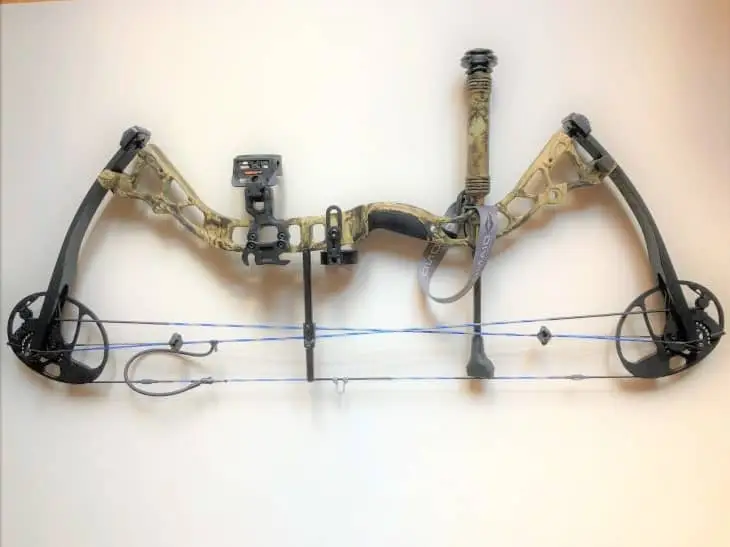
What are Side Rods (aka Side Bars), and What are V-Bars?
If you look closely at the bows used by professionals in competition, you may realize that in addition to the standard stabilizer below the grip that extends forward toward the target, they also have additional bars, called side rods, installed. A side ride will be a bar that is added to the right side or the left side of a bow, and it’s generally used to even out the weight of a bow. If a hunter is using a quiver that’s mounted on one side of his riser, he may add a side bar on the side of the riser opposite the quiver to balance things out, and if a target archer finds that he/she is veering to one side, they might “correct” their shot with a side rod. A side rod basically adds lateral weight below the riser on your bow, limiting left/right movement, helping to improve overall balance, and you can see this lady below has a side rod on the left side of her bow:
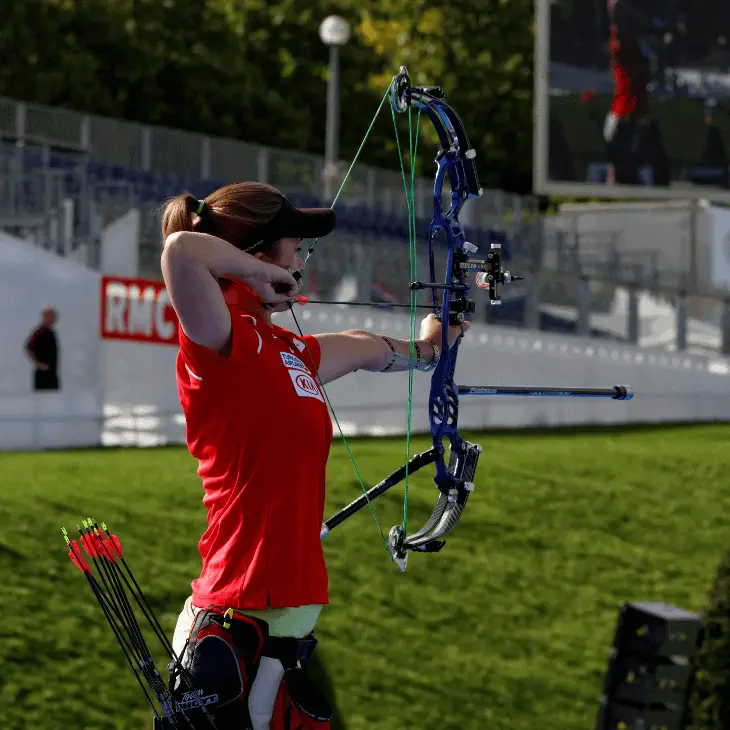
Like other stabilizers, side rods are generally made from composite materials that are both durable and good for reducing the vibrations and torque from each bowstring release. Most archers choose to mount them on the opposite side of the bow from your body. The idea here is that the rods help by counteracting the weight of your sight.
Others prefer to use one rod on both sides of their bow. There are special mounting devices, called V-bars, that allow you to easily mount two side rod stabilizers on your bow for added stability. The setup you choose will depend on your shooting style, your other accessories, and where you plan to shoot. As you can see below, this guy has a V-bar on his bow, and stabilizers that extend back on both sides of his bow:
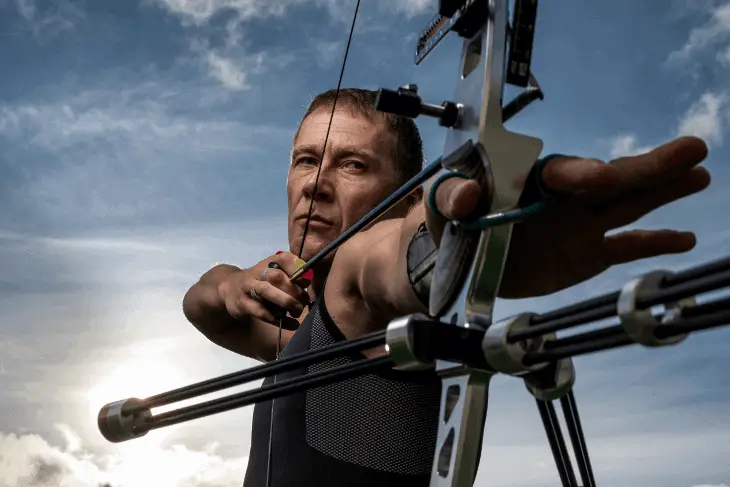
Regular bow stabilizers—the type that extends away from your bow towards your target—and V-bars (the kind the guy above is using) are symmetrical, and it’s safe to say that most archers can incorporate them into their shot process. Incorporating a side rod, however, is a little more complicated, and you’d need to experiment with one to see if it works for you. You can always visit the range and ask for some guidance, or talk to a friend who’s used one.
How Do Stabilizers Actually Work?
This particular piece of equipment may seem pretty simple—after all, it’s a rod—but modern stabilizers are actually precision tools, and carefully designed, from their material components to their weight to their exact length, and they’re effective because of a simple trick of physics.
As we mentioned in the last section, when you pull the bowstring on your bow, it creates potential energy that spreads throughout the entire bow: the string, the riser, the limbs, the whole enchilada. Different bows have different levels of resistance, and the higher the poundage on the bow, the more potential energy each pull-back generates. At full draw, the bow is taught and wants to return to release that energy and return to its natural shape and form, and when you let go of the bowstring, much of the energy goes into the arrow, but the rest of it moves through each part of the bow. The power of your shot jerks the bow around, creating vibrations that travel through the string, the bow, any accessories on your bow, and your hand.
There are three ways that stabilizers use physics, and a little bit of chemistry, to eat up that vibration and make the bow more stable:
Rigidity of the Stabilizer. You may remember from our post about “How to Select Arrows” that every arrow has “spine.” Spine is basically the degree of bend-ability of the arrow. Bendable arrows are for bows with a low draw weight, but bows with a high draw will require really stiff arrows, because a “flimsier” arrow will squirm like a snake before it clears the arrow rest.
The same idea is true for stabilizers. You want the rod of your stabilizer to be as close to unbendable as possible. A wobbly stabilizer might actually make your shot less reliable, because it’s bend and wobble and introduce MORE movement to shot, instead of less. Equipment manufacturers use incredible strong materials to ensure that stabilizers are incredibly rigid.
Keep in mind, we’re talking about the actual pole in the stabilizer, and not the dampener—it’s OK if that shakes, because that’ll eat up some vibration from your shot. More on that in a moment.
Weight of the Stabilizer. This is related to rigidity. A heaver stabilizer will more effectively eat up vibrations than a flimsy one. Imagine attaching a long piece of hay to your bow—that wouldn’t do much, right? A stabilizer needs to have some heft to absorb the movement from the shot. The challenge for equipment manufacturers is producing a stabilizer that weights enough, but not too much.
Stabilizer Material. Remember a moment ago, when we said that chemistry comes into play? Most stabilizers incorporate some kind of “dampening” material, with rubber being the most popular. The rubber is incorporated into the overall structure so that it gobbles up some of the reverb, without sacrificing the “rigidness” of the rod. Here’s an image of a hunting stabilizer, that has external rubber parts to subdue some of the vibration:
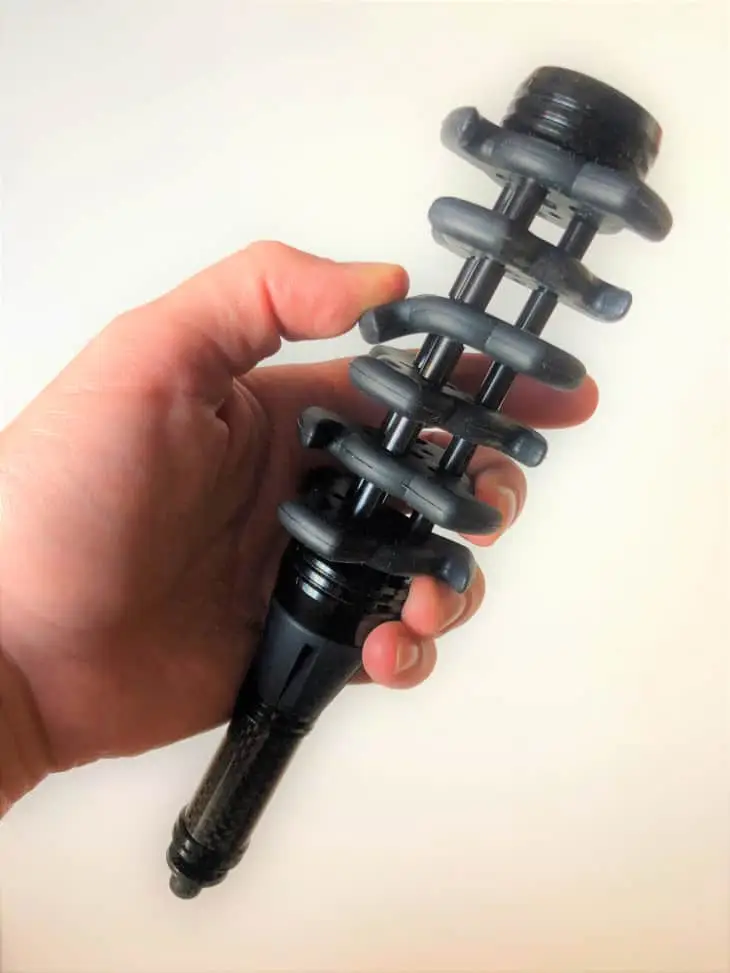
On some stabilizers (like the one in the photo), that vibration-dampening material is on the outside; on other stabilizers, that material is one the inside of the stabilizers. Usually it’s only high-end stabilizers that have vibration-dampening material inside the length of the stabilizer, as it takes a lot of R and D (research and development) to develop that tech. In fact, there are companies who sole product is vibration-dampening material, and they have entire teams of scientists devoted to that task and that task alone. Pretty cool!
Before we wrap up, we’ll say it one last time: it’s important to keep in mind that different lengths of stabilizers work slightly differently and offer different benefits. The shorter, thicker stabilizers with rubber are great for reducing vibration and noise, but may not offer as much stability; longer stabilizers provide more grounding, but may not do so much for noise.
Do I Really Need One of These Things?
Nope! Plenty of folks don’t use a stabilizer and never will. Stabilizers are not required, in any way, to shoot a bow, be accurate, and enjoy what you’re doing. Plenty of people don’t like the feel of stabilizers, and plenty of other folks simply don’t like the endless modifications that modern archery seems to promote. If you’re into traditional archery, roving, or archery tag, stabilizers really aren’t necessary. With adequate practice and appropriate coaching, you should be able to develop your skills, with or without a stabilizer.
That said, there are two things to keep in mind…
The higher up climb on the competitive ladder, the more you’re going to see stabilizers. If you type “Olympic archer” in your favorite search engine and look at some of the photos that pop up, you might have a hard time finding an image that doesn’t feature an archer with a stabilizer and V-bars. In terms of accuracy, when stabilizers are combined with a training regimen, they can really prove worthwhile. And…
Hunters absolutely love them. So much so, that bow manufacturers who make hunting compounds usually feature a stabilizer that comes with the bow. The Diamond Infinite Edge—a great hunting bow for beginners—usually comes with a short black stabilizer screwed into the riser. Hunters really enjoy the added stability, but REALLY like the sound-dampening qualities.
That’s the Skinny on Stabilizers
We hope that helps. If you have any questions, mosey on over to a “Contact” page and ask away—we’d love to help. Good luck, have fun, and safe shooting!


